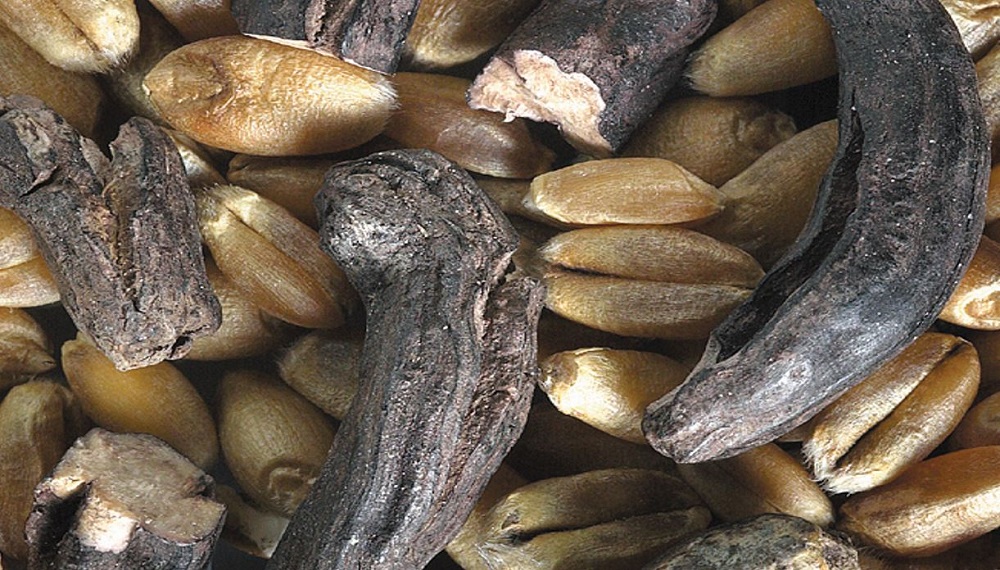Ergot in UK cereal crops and changing legislation
Tuesday, 18 October 2022
Following the EU’s lead, GB may introduce maximum levels for ergot alkaloids in cereals and their products. Dhan Bhandari, who manages grain quality research at AHDB, explains what this could mean for farmers.
Ergot is a fungal disease of grasses (including black-grass) and cereals. In order of decreasing crop susceptibility, the disease affects rye, triticale, wheat, barley, and oats (infection of oats is rare).
The pathogen enters flowers and infects (female) tissues, replacing each developing grain with an ergot sclerotia.
The sclerotia is associated with multiple forms of toxic alkaloids, which can enter the food and feed chain. In humans, these mycotoxins can cause ergotism (which is rare in modern society).
As contaminated grain, fed to stock or used to make flour, can pose a risk to animal and human health, it may be rejected, require cleaning or demand a reduced price.
The AIC Contract for Grains/Pulses No.2/16 states that: “grain shall not contain more than 0.001% ergot by weight for feed grain and zero tolerance for all other grain.”
Ergot alkaloids are found in some cereal grain lots even where there is no obvious sclerotia. This is because of the presence of contaminated fragments and dust. As a result, attention is shifting towards the measurement of alkaloids, because they are a stronger indicator of risk.
EU ergot limits
The EU recently revised the limits for ergot sclerotia and alkaloids, which applied from 1 January 2022. These are not in GB-retained EU law, although adoption is due to be considered. The EU maximum levels (MLs), which already apply in Northern Ireland, are as follows.
Ergot sclerotia ML is 0.2 g/kg in unprocessed cereals, except for maize, rye and rice.
Ergot alkaloids MLs for cereals and milling products of barley, wheat, spelt, and oats are:
- For ash content lower than 900 mg/100 g (e.g. white flour) is 100 μg/kg (50 μg/kg from 1 July 2024)
- For ash content equal to or higher than 900 mg/100 g (e.g. wholemeal flour) is 150 μg/kg
- The ML for barley, wheat, spelt and oats grains placed on the market for the final consumer is 150 μg/kg
- The ML for processed cereal-based food for infants and young children is 20 μg/kg
UK ergot alkaloid levels
AHDB funds a project to monitor levels of various contaminants in representative commercial samples of UK-grown wheat, barley, oats, and co-milling products (wheatfeed and oatfeed).
Since 2016, levels of total ergot alkaloids have been monitored. Generally, levels are low enough not to cause concern. However, there are occasions when levels are higher in some categories. For example, the 2021 harvest was associated with raised alkaloid levels in some milling wheat, wheatfeed and feed barley samples.
The project is yet to report its findings for harvest 2022. However, there appears to be a mixed picture, with ergot sclerotia found at higher-than-usual levels in some growing locations, according to regional reports.
The final AHDB commercial harvest progress report (September 2022) stated that, overall, only limited amounts of ergot were detected in wheat and barley samples from central stores. However, there were increasing reports of ergot noted in the East Midlands.
There have also been anecdotal reports of higher-than-usual levels of ergot in wheat samples in parts of Kent, Lincolnshire, and the wider Midlands. Rejection of loads at intake by some millers has also been reported.
Ergot management
With GB ergot alkaloid MLs under consideration, the whole supply chain must work together to understand and manage risk.
For farmers, this means knowing how husbandry influences ergot-infection risk and how to manage potentially contaminated grain.
- Deep cultivation reduces risk, as ergots cannot germinate at soil depths greater than 4 cm
- Prolonged cool and wet conditions facilitate spore production and extend the flowering period, so growers should avoid open-flowering varieties and those with a long flowering period
- As deficiencies in copper and boron can reduce pollen viability and extend the flowering period, applications of these micronutrients may help (where soil tests indicate a deficiency)
There are many factors that influence risk and various control measures. These are detailed on the AHDB ergot management page.
 AHDB
AHDB
.JPG) AHDB
AHDB

